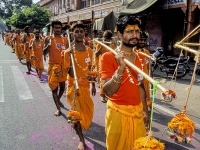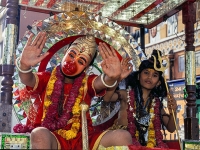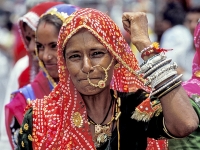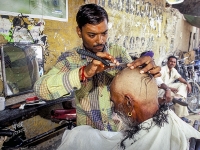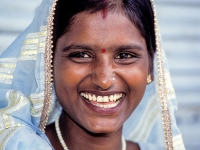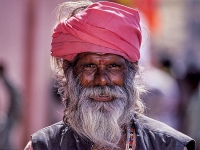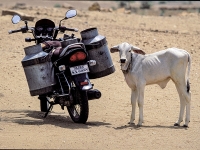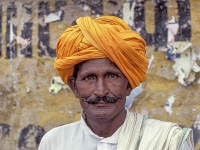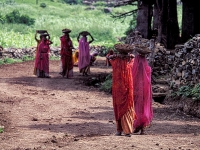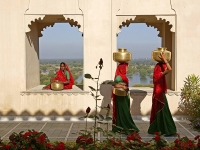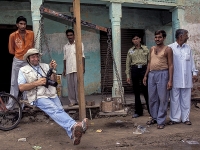Reisen
India: Customs and habits to immerse yourself in local culture
Customs Culture Color of India
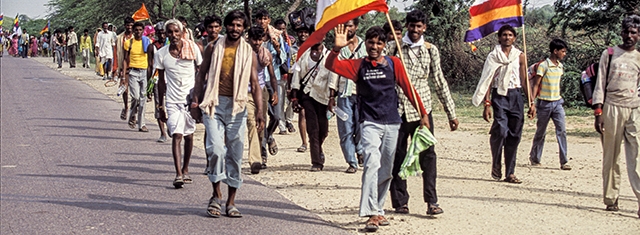
india everyone is walking towards the ganges river (Quelle: Roberto Magni By Foto ReD Photogeaphic Agency)
Foto ReD Photographic Agency -
India is a fascinating country rich in culture: let's discover its uses and habits, so as not to be unprepared for a trip to Indian land.
It is good to underline that in India the shy and gifted with particular sensitivity do not have an easy life.
It is good to underline that in India the shy and gifted with particular sensitivity do not have an easy life.
The Indians are extremely kind but have a particular fondness for people with a strong and decisive character, which they respect deeply. The tone in which we turn, especially to subordinates, can be viewed offensively by people belonging to another culture, instead this is a way to assert one's firmness and authority and receive respect from others. On the other hand, living conditions are often very difficult and having a certain pulse in dealing with situations allows the Indian people to go on without losing heart.
A lot has been said about Indian hospitality: the Indians willingly open the door to everyone because they consider the guest sacred, equal to God. If you receive an invitation to lunch, it is good to first refuse food twice and only to third request accept. The Indians eat at the table or on mats lying on the ground, consuming food strictly with their hands. It is important to remember not to leave anything on the plate, because it is considered bad education and disrespect for those who starve.
In addition to the hands, a lot of attention is given to the feet, which are considered impure. If you accidentally touch someone with your foot, the gesture is considered an offense and, to repair the shame, you first touch the person hit with your right hand, then you touch your eyes - first the left and then the right - to apologize. Another habit to watch out for: never point your feet to an elderly person sitting across from you. Shoes must be removed in places of worship, except in Catholic churches. It is not difficult to understand where you need to enter barefoot, thanks to the indications and the number of slippers and shoes present at the entrance to these places. Even when you enter someone's home it is good practice to take off your shoes, to avoid the landlord getting annoyed and taking the gesture as disrespect.
Visiting India another of the characteristics that affects western visitors is the queue, regulated by specific rules. First of all, the distance between one person and the other should not be greater than the length of the arm between the elbow and the fingertips of the outstretched hand. If the distance should be greater, the person behind feels authorized or to push to decrease it or, even, to override and take the place of the person who precedes him, without this uttering a word.
In India there are still combined marriages, that is, those between a man and a woman who do not marry for love but for interest. The choice is usually made by families and more often than not young people approve of this custom. Only after the parents met and discussed the wedding, the future spouses meet to get to know each other and give their consent to the ceremony. In more traditional families, young people meet for the first time on their wedding day and have no say in the choice.
India is a country where people are very kind and polite and do not use to refer by name to a person of older or higher rank. It is difficult to find people who are called by name, nicknames and nicknames are widely used, the wife never pronounces the husband's name but calls him "husband" or "lord". The language spoken across the country is Hindi but the second official language is English.
It is important to know that in India people are organized in castes, with brahmans (priests) at the top and shudras (servants) at the bottom. All roles are scrupulously respected and one's position comes esplicitata from the title, which is affixed to the name. This position can be improved by continuing your studies or by showing that you have a large bank account.
Hardly a man and a woman kiss and embrace in public but men are used to walk holding hands, without fear that their virility will be questioned. Homosexuality, however, is not well viewed and is considered a crime.
Men are also very vain and take care of the body, often going to beauty salons, where they get massaged, combed and perfumed. Walking through the streets you can come across barbers who do their job on the sidewalks. Hair is very important in Indian culture, when a parent dies, the children shave to zero. Even the first hair of children is shaved and thrown into the river, as are those of widows.
Indian men wear dhoti, a cotton cloth that wraps around the hips and is then passed between the legs and over a canvas shirt. Others wear long tunics with tight trousers.
Impossible not to notice also the beauty and colors of Indian women, who wear the sari, a long band of fabric wrapped around the body, ending with a colored flap. Of course, the fabrics and types of saris vary according to the woman's financial resources. Indians love to adorn their arms with colorful jewelry and bracelets and wear large necklaces and dangling earrings. Muslim women dress instead with salvar kameez, also covering their heads with veils. Indian women do not use much make-up, if married they wear tilak, a red dot on the forehead. The use of khol to emphasize the eye area is common to women, men and children, especially for the antiseptic properties of this cosmetic powder. Unfortunately, the woman is considered inferior to the man and is still discriminated against, both at work and in the family
The Indians are very superstitious and use to hang a lemon with green peppers on their doorsteps to ward off negative energies.
Although hygiene conditions seem to be lacking, Indians are a people who particularly care about personal cleanliness. They never leave the house without having washed perfectly and consider foreigners not very well-behaved.
Hard to believe because in villages it is not uncommon to find the floor covered with cow dung, which is used to disinfect, being a powerful antibacterial. This is also because Indians have a habit of sitting on the ground, cross-legged, in the position that is called "sukhasana".
". This position promotes relaxation and helps digest, furthermore, continually getting up from the ground, keeping the knees in shape, which remain strong even in old age.
Another particular custom is to take the train by literally launching yourself inside or to stay in the balance even while the train is moving. This situation is repeated when they have to get off: passengers jump from the carriages while others try to get on.
weitere Informationen: https://www.redmagazine.red
India Foto Red Photographic Agency Red Magazine Redmagazine Roberto Magni Comi Daniela Color Of India Customs Of India
Für den Artikel ist der Verfasser verantwortlich, dem auch das Urheberrecht obliegt. Redaktionelle Inhalte von GDN können auf anderen Webseiten zitiert werden, wenn das Zitat maximal 5% des Gesamt-Textes ausmacht, als solches gekennzeichnet ist und die Quelle benannt (verlinkt) wird.

